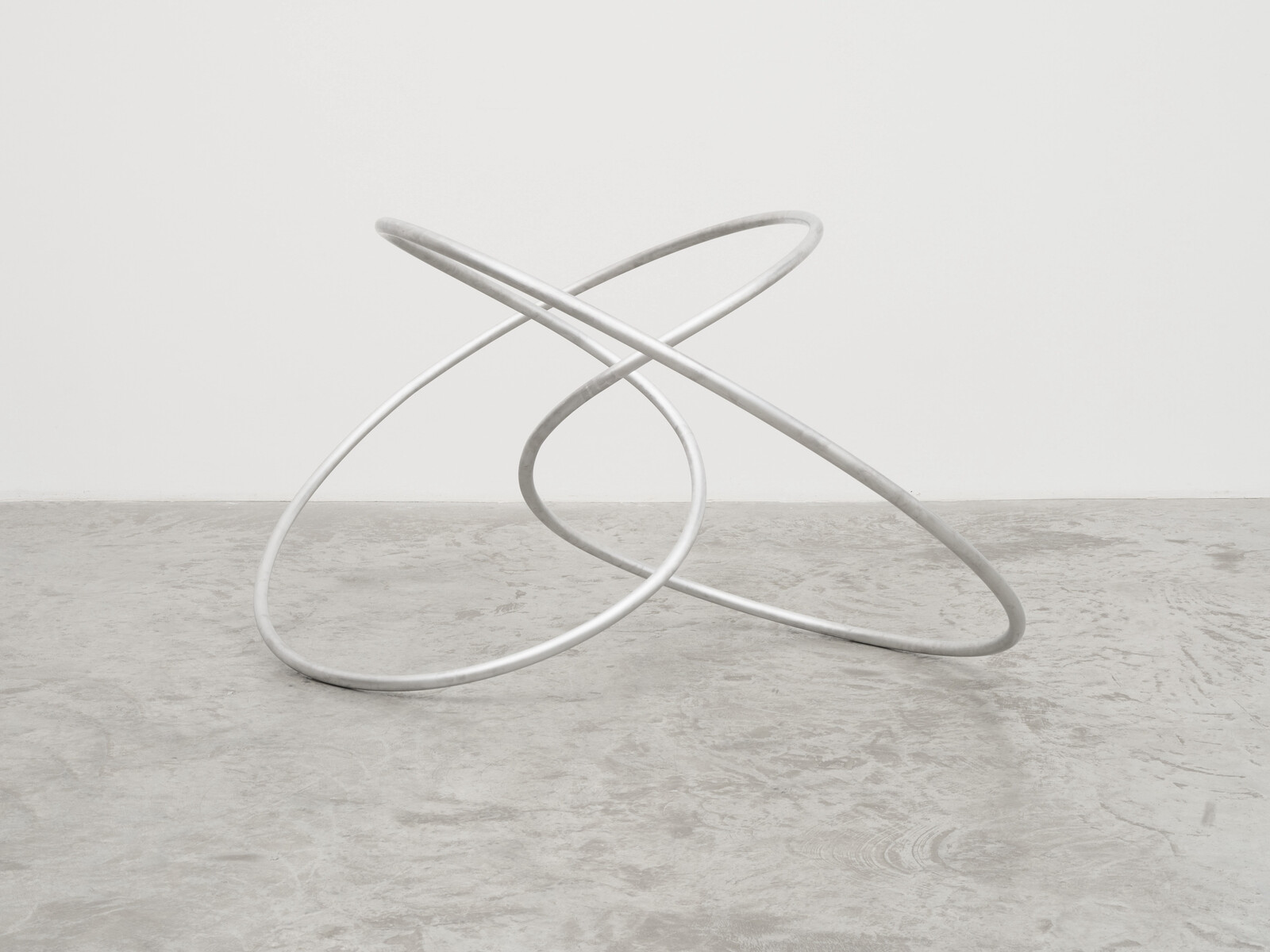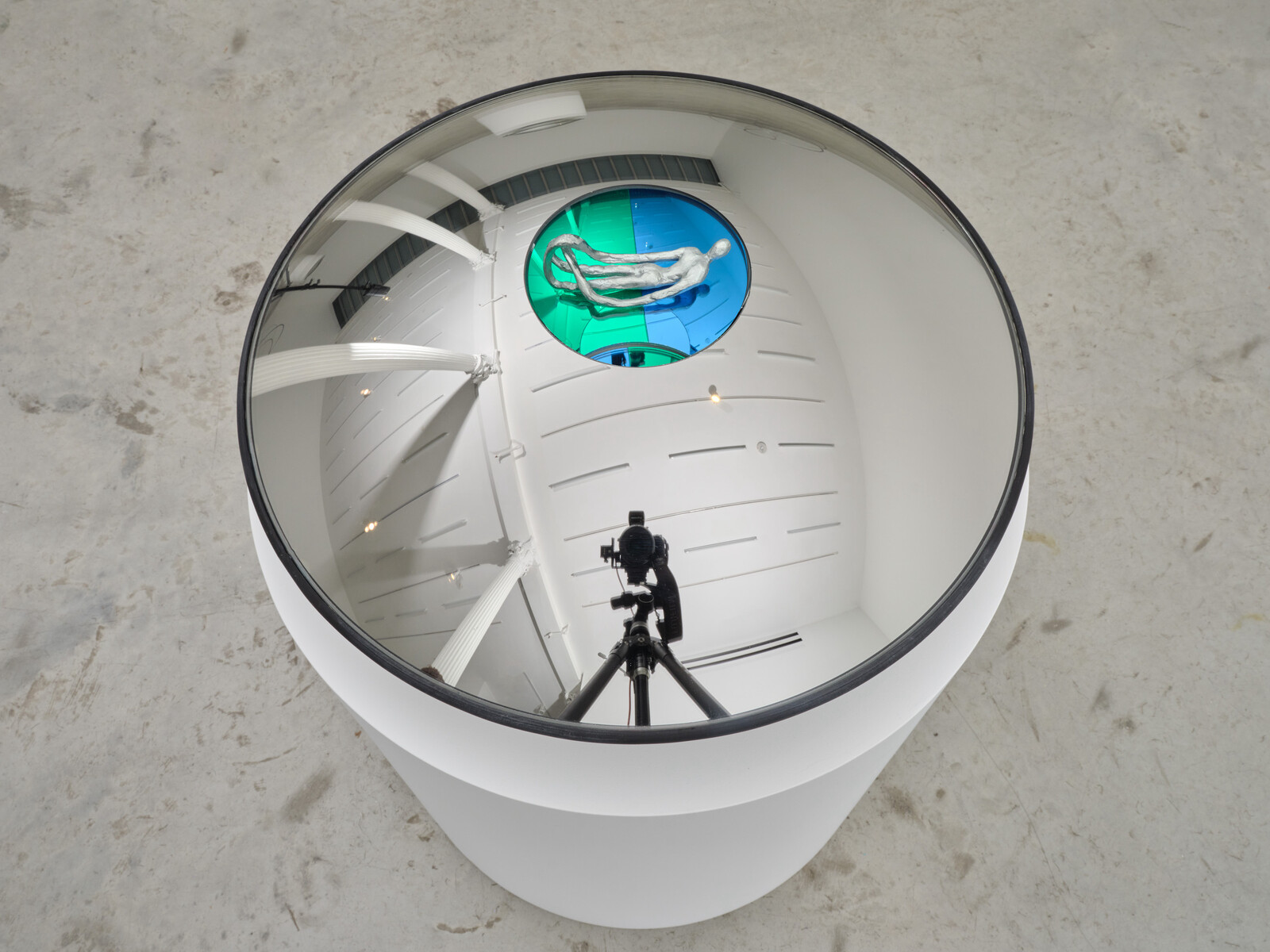In profile, the six rounded disks at the center of Madeline Hollander’s latest exhibition appear glamorously extraterrestrial, the bright bulbs of the track lighting glinting in their polished chrome surfaces. Arranged in a grid on curved, white pedestals, the satellite-shaped objects are constructed from parabolic mirrors, a hole cut at the top of each to reveal a sinewy figure cast in aluminum, revolving atop a bifurcated circle of colored glass. Based on Hollander’s personalized notation system, specific silhouettes and colors correspond to a precise movement so that, taken in concert, the six figures play out an entire choreography, spinning perpetually in place.
Viewed at the right angle, the maquette doubles, ascending out of the mirror like a ballerina from a jewelry box to create the illusion of a perfect pas de deux—not a limb out of place, nor a posture skipped, as both “dancers” rotate in flawless synchronicity. Titled Entanglement Choreography I-VI (all works 2023), the objects are designed as miniaturized visualizations of quantum entanglement, the theory that two particles can be interdependent, mimicking one another across both space and time, the action of one entirely conditional on that of its partner. Quick and loose with her interpretations of the thesis, Hollander mines the concept for lyricism, retools it, and filters it through the lens of a danced duet.
The same principle—physics made manifest, made to dance—undergirds the three waist-height silver knots perched in the corners of the room. Prodded with enough force, each elegant tangle will lumber forward, the individual curvatures designed so that a gravitational pull tugs the sculpture into unceasing motion. Both the Entanglement pieces, and the knotted sculptures — cheekily anthropomorphized with titles such as Charlie, Alice, and Bob — translate the scientific and systematic into the poetic, expanding the former’s capacity for symbolic meaning.
Classically trained in ballet, and equally inspired by the radical simplicity of modern dance championed by Anna Halprin and Yvonne Rainer, Hollander’s reverence for the everyday fits neatly into the lineage of the Judson Dance Theater and the San Francisco Dancers’ Workshop. She understands how attention confers dignity, and has wielded this across her practice to elevate the mundane. Turning her choreographer’s eye to everything from disaster-preparedness trainings to water circulation systems, Hollander has consistently produced performance out of the social and scientific forces that govern our daily lives, arguing in the process for a possible reversal, whereby routine might be viewed with the wonderment usually reserved for art. She pokes at the academic, the textual, and the mathematical, using each as material for her movement.
This translation of ideas from one field into another, or what Mieke Bal describes as the traveling of a concept, necessarily expounds upon meaning. As Bal outlines, to translate is to rearticulate, and in rendering plastic the form of a theory, its meaning inevitably shifts, accumulating new undercurrents and implications along the way.1 At its best, Hollander’s practice reworks pattern and movement usually taken for granted into something that while original, nevertheless retains the shadow of her source material. The work charts its own evolutionary path, emphasizing the gap between an initial inspiration and its final manifestation. In Entanglement, we’re privy to the dance itself, but the scientific idea that sparked it remains legible in the clinical materials and mechanical perfection of the works.
The sculptures in the gallery’s main room catalogue ideal gestures. Here, motion is largely unburdened by the fallibility of a human body: forever swirling, endlessly falling. Yet the dancer is made present through her palpable absence. Charlie, Alice, and Bob are individually coded to move with a distinct tempo, a uniqueness impossible not to read as a kind of personality. Even the grid-like arrangement of the pedestals, and the serial rows of near-identical forms, echo the stylistic tropes of Minimalist objects, calling to mind their phenomenological edge and dialing up bodily awareness. The implication is that there is something beautiful about the risks of living in a world where theory fails. Yes, theoretically an object in motion could keep moving indefinitely; but here, a wall girds its trajectory. The dancers might flutter out of lockstep, but the partnership, the interdependence of the choreography remains. Whether imaged through science or bodies on stage, the entanglement is undeniable.
See Mieke Bal, Traveling Concepts in the Humanities: A Rough Guide (Toronto: University of Toronto Press, 2002).




